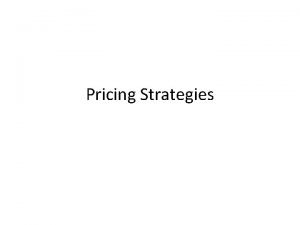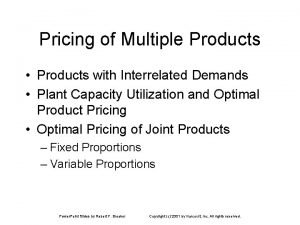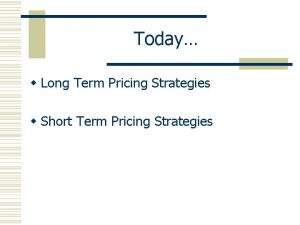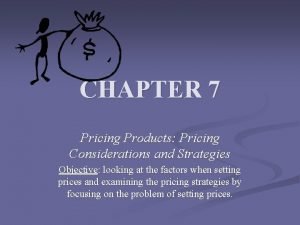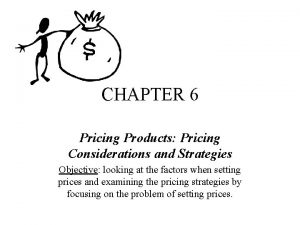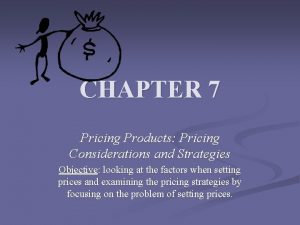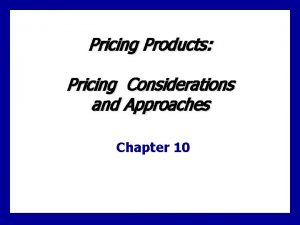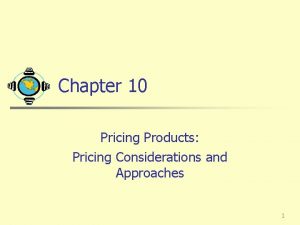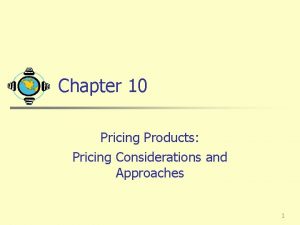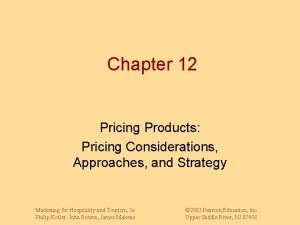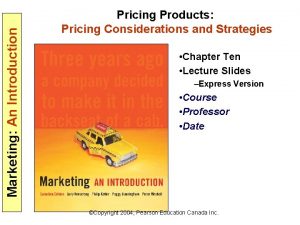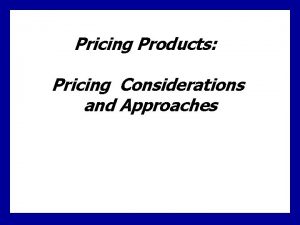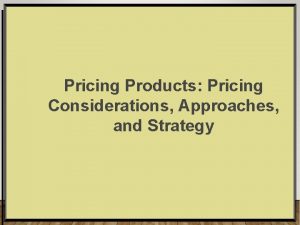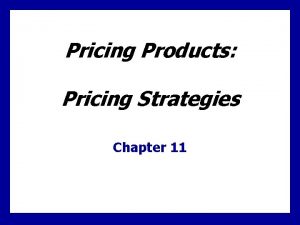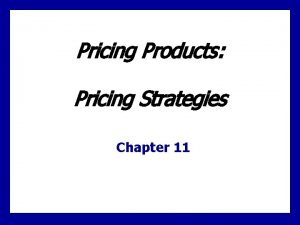Chapter 11 Pricing Products Pricing Considerations and Strategies



















- Slides: 19

Chapter 11 Pricing Products: Pricing Considerations and Strategies 1

New Product Pricing Strategies Market Skimming Ø Setting a High Price for a New Product to “Skim” Maximum Revenues from the Target Market. Ø Results in Fewer, But More Profitable Sales. Use Under These Conditions: n n n Product’s Quality and Image Must Support Its Higher Price. Costs Can’t be so High that They Cancel the Advantage of Charging More. Competitors Shouldn’t be Able to Enter Market Easily and Undercut the High Price. 2

New Product Pricing Strategies Use Under These Conditions: n n n Market Must be Highly Price -Sensitive so a Low Price Produces More Market Growth. Production/ Distribution Costs Must Fall as Sales Volume Increases. Must Keep Out Competition & Maintain Its Low Price Position or Benefits May Only be Temporary. Market Penetration Ø Setting a Low Price for a New Product in Order to “Penetrate” the Market Quickly and Deeply. Ø Attract a Large Number of Buyers and Win a Larger Market Share. 3

Product Mix-Pricing Strategies: Product Line Pricing Involves setting price steps between various products in a product line based on: n n n Cost differences between products, Customer evaluations of different features, and competitors’ prices. 4

Product Mix- Pricing Strategies Optional-Product n Pricing optional or accessory products sold with the main product. i. e camera bag. Captive-Product n Pricing products that must be used with the main product. i. e. film. 5

Product Mix- Pricing Strategies By-Product n n Pricing low-value by-products to get rid of them and make the main product’s price more competitive. i. e. sawdust, Zoo Doo Product-Bundling n n Combining several products and offering the bundle at a reduced price. i. e. theater season tickets. 6

Discount and Allowance Pricing 7

Segmented Pricing 8

Psychological Pricing Valu e $2 2. 00 Sale $14. 99 Considers the psychology of prices and not simply the economics. Customers use price less when they can judge quality of a product. Price becomes an important quality signal when customers can’t judge quality; price is used to say something about a product. 9

Promotional Pricing Loss Leaders Temporarily Pricing Products Below List Price to Increase Short-Term Sales Through: Special-Event Pricing Cash Rebates Low-Interest Financing Longer Warranties Free Merchandise Discounts 10

Discussion Connections Many other industries have created “deal-prone” consumers through the heavy use of promotional pricing - fast foods, airlines, tires, furniture, and others. Pick a company in one of these industries and suggest ways that it might deal with this problem. How does the concept of value relate to promotional pricing? Does promotional pricing add to or detract from customer value? 11

Other Price Adjustment Strategies Adjusting Prices to Account for the Geographical Location of Customers. Pricing • i. e. FOB-Origin, Uniform. Delivery, Zone Pricing, Basing Point, & Freight-Absorption. • Geographical International • Adjusting Prices for International Markets. Pricing • Price Depends on Costs, Consumers, Economic Conditions, Competitive Situations & Other Factors. 12

Initiating Price Changes Why? Excess Capacity Cost Inflation Falling Market Share Overdemand: Company Can’t Supply All Customer’s Needs Dominate Market Through Lower Costs 13

Bei ng Cu Nu Re mb rre pla Price Cuts Are Seen When: er nt by Buyers As: Competitors Reactions ce of Mo d Fir del Co by Pro ms s m Ne duc is Buy pa Ar we t. Sm is ers ny er Uni all Qu are is Mo No for alit We in del t m y ll Fin s Sel Ha Inf an Pri lin s or cia ce g Be me l Co W en d Tr m ell Re ou es du ble Do ce wn 14 d Reactions to Price Changes

Assessing/Responding to Competitor’s Price Changes (Fig. 11. 1) 15

Public Policy Issues in Pricing (Fig. 11. 2) Manufacturer A Price-fixing Predatory pricing Manufacturer B Retailer 1 Retail price maintenance. Discriminatory Pricing Price-fixing Predatory Pricing Deceptive Pricing Consumers Retailer 2 Deceptive Pricing 16

Public Policy Issues in Pricing Within Channel Levels Price Fixing Predatory Pricing 17

Pricing Across Channel Levels Price Discrimination Resale Price Maintenance Deceptive Pricing Ensure Sellers Offers the Same Price Terms to a Given Level Of Trade Manufacturer Can’t Require Dealers to Charge a Specified Retail Price for Its Product Occurs When a Seller States Prices or Prices Savings that Available To Consumers 18

Review of Concept Connections Describe the major strategies for pricing imitative and new products. Explain how companies find a set of prices that maximizes the profits from the total product mix. Discuss how companies adjust their prices to take into account different types of customers and situations. Discuss the key issues related to initiating and responding to price changes. 19
 Writing strategies and ethical considerations
Writing strategies and ethical considerations Pricing considerations and approaches
Pricing considerations and approaches Chapter 26 pricing strategies answer key
Chapter 26 pricing strategies answer key Segmented pricing
Segmented pricing Chapter 26 pricing strategies
Chapter 26 pricing strategies Chapter 9 pre examination/preanalytical considerations
Chapter 9 pre examination/preanalytical considerations Functional product
Functional product Pricing and distribution
Pricing and distribution Developing price strategies and programs
Developing price strategies and programs Global pricing objectives and strategies
Global pricing objectives and strategies Segmented pricing
Segmented pricing Developing pricing strategies and programs
Developing pricing strategies and programs Developing pricing strategies and programs
Developing pricing strategies and programs Marketing mix of pepsi and coca cola
Marketing mix of pepsi and coca cola Ethical considerations in experimental research
Ethical considerations in experimental research Multiple product pricing can be for
Multiple product pricing can be for Short term pricing strategies
Short term pricing strategies Captive-product pricing
Captive-product pricing What is differential pricing strategy
What is differential pricing strategy Pricing in retailing
Pricing in retailing


